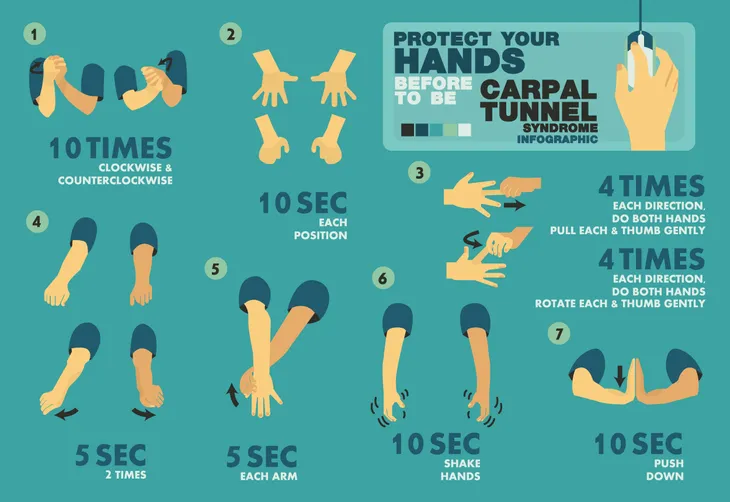Do you have numbness, a tingling sensation, or weakness in your hand? You might be suffering from carpal tunnel syndrome, also known as median nerve compression. This nerve-related disorder plagues three times more adult women than men, particularly those who type for long periods of time or perform assembly line work. The syndrome itself can be temporary, but it’s often the result of repetitive stress that persists and gradually worsens.
What Is Carpal Tunnel Syndrome?
First, it’s important to have an understanding of the condition. Carpal tunnel syndrome affects the median nerve in the carpal tunnel in the wrist. This tunnel is made up of bone, tendons, tissue, and the median nerve that travels into the wrist, hand, palm, and fingers to allow free movement.
If the tunnel swells, pressure and inflammation will compress the median nerve, causing severe pain and tingling sensations or numbness. Be on the lookout for the following symptoms of carpal tunnel and book an appointment with your doctor if they develop.
Numbness and Tingling
One of the most common symptoms of carpal tunnel syndrome is numbness or a tingling sensation. It’s often felt in the thumb, index, middle, or ring fingers, but the little finger isn’t usually affected, explains the Mayo Clinic.
The source also notes that the sensation may feel like “an electric shock.” It can also travel from the wrist up the arm. While the sensation may happen occasionally, the source says over time, the numb feeling may become more constant.
Painful Burning Sensations
As the condition worsens, the numbness may be overcome by what other individuals describe as shooting pains or burning. This pain is often felt in the forearm, wrist, hand, and/or fingers.
Oftentimes the pain can come on suddenly and it may shoot up your hand, wrist, and/or forearm. If the pain becomes unbearable try icing the area for immediate relief. Then, you should contact your doctor for a proper diagnosis and treatment plan.
Hand Cramping
Hand cramps, which can affect the palm, fingers, wrist, and even move up the forearm, are both irritating and extremely painful. They’re also a key sign of carpal tunnel syndrome.
The best way to restore normal sensation is to shake and massage the fingers, palm, and/or wrist to ease the cramps. However, be sure to do so gently.
Muscle Weakness
As carpal tunnel syndrome progresses and inflammation worsens, you may find that your grip strength is affected. This means you may not be able to grip objects with the same strength as you used to.
In some cases, you may even lose your grip on objects and actually drop them accidentally. Be on the lookout for this symptom and contact your doctor if you start noticing muscle weakness.
Disrupted Sleep
Are you having trouble sleeping? Perhaps you’re waking up several times per night due to hand pain and numbness. This could be a key sign that you have carpal tunnel syndrome.
Carpal tunnel syndrome is exacerbated during sleep. Really, it’s the position in which you sleep (i.e., especially if you flex your wrists when sleeping). This position also encourages fluid accumulation in the wrists and hands that won’t drain when you’re lying flat, which also encourages cramps and numbness.
Muscle Wasting
Another damaging side effect of carpal tunnel syndrome is muscle wasting (or atrophy). This typically doesn’t happen until the advanced stages.
You will first notice muscle wasting in the affected hand, particularly in the muscles situated under the thumb where it attaches to the palm, which is known medically as the thenar eminence. If you notice muscle wasting, this is a good indicator that the sensory fibers have already been damaged for a while.
Morning Muscle Stiffness
It’s extremely common for individuals with carpal tunnel syndrome to wake up in the morning with stiff, numb, or tingling wrists, hands, and fingers. In some cases, the sensation may run all the way to your shoulder, says WebMD.
The source says, early on in the condition, you may find relief by shaking out or massaging your hand, wrist, and/or fingers to restore normal feeling and soothe tingling and numbness. However, over time, this may not make the sensation go away.
Common Causes of Carpal Tunnel Syndrome
Along with knowing how to spot carpal tunnel, it’s important to understand why it happens. WebMD points out that people often don’t know what triggered carpal tunnel syndrome to develop; however, there are a variety of causes that could be the culprit.
The source says repetitive motions such as typing, sewing, driving, writing, or any motion that involves using your wrist over and over can cause carpal tunnel syndrome. Certain conditions may also play a role in the development of carpal tunnel syndrome such as obesity, hypothyroidism, diabetes, and rheumatoid arthritis. The source says even pregnancy might play a role in its development.
When to See a Doctor
If you develop symptoms of carpal tunnel syndrome, you should book an appointment with your doctor, even if your symptoms come on intermittently. WebMD says the condition is easier to treat when diagnosed early. Early intervention can also help prevent permanent muscle damage and help keep your hand functioning properly.
To diagnose carpal tunnel syndrome your doctor will perform a variety of tests. They will likely start with a test to check for Tinel sign by lightly tapping over the affected nerve to see if you have a tingling sensation. Imaging tests (such as X-rays, ultrasound, or magnetic resonance imaging [MRI] scan) or an electromyogram may also be necessary.
Treatment
There are a variety of treatment strategies for carpal tunnel but what your doctor recommends will depend on your symptoms as well as how far it has progressed. For starters, your doctor may advise lifestyle changes such as taking breaks when doing repetitive motions.
Your doctor may also recommend exercises that can help stretch and strengthen your wrists and hands. Or your doctor may recommend that you wear a splint to prevent your wrist from moving. In some cases, medication or surgery may be necessary but ultimately, it’s important to follow the advice of your medical team.
Can Carpal Tunnel Syndrome Be Prevented?
While it can’t always be prevented, certain lifestyle adjustments may help decrease your chance of developing it. For starters, NYU Langone Health says minimizing repetitive hand movements and alternating between tasks and activities can help reduce strain on your wrists and hands.
The source also recommends keeping your wrists straight or in a neutral position when using them. If you work in an office, making your workstation more ergonomic (such as adjusting your desk, chair, and keyboard to keep your forearms level with your work surface) may also help prevent the condition.















